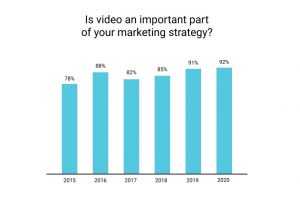Are you building a better blog strategy for the new year?
Your blog can, and should be one of your best sales tools. There should be a consistent blog strategy or content marketing strategy in place to guide your digital business.
Your blog is a powerful resource when it comes to building your online business for the upcoming year. It’s a natural platform built into most sites, that readers have come to expect.
Yet…
It’s easy to feel like you are spinning your wheels. It is easy to feel like you are spilling your blood onto the page and wonder if anyone is actually paying attention. The new year is the perfect time to take stock of a powerful marketing resource and make sure you are using it in a way that best benefits your business.
B2B marketers who blog receive 67 percent more leads than their counterparts who do not, according to Hubspot. These are leads attracted without any extra effort by your sales force. They are leads that likely came to you. So keep at it, and make sure you are creating a message that resonates with your audience, if you want to develop a blog strategy to help you sell.
Tips for a better blog strategy in 2016:
Are you coming up with strong blog ideas?
This is the most basic place to start when it comes to developing a blog strategy for the upcoming year. The question you’ll need to answer is this: Does your audience care about what you have to say?
If the answer is yes, keep doing what you are doing. Keep finding ideas the ways that you have been. But if not, you may need to take a step back to reconnect. Here are some ways to develop blog ideas with your audience in mind:
- Ask your audience what kind of topics they want to know more about in the new year.
- Think back to the questions your audience most frequently asked, and write posts based on those questions.
- Use Google Keyword Planner to develop post ideas directly around the most heavily used keywords. These will be the topics that have a naturally built in audience.
- Determine what stories you can tell. Do you have some great customer success stories? Can you tell people how your business originated? Data backs up a larger point. Stories are remembered.
- Scour your industry blogs, newsletters and resources. What information does your audience need to know? Can you break it down for them in a way that will resonate?
- Connect two ideas or concepts previously unrelated. What does your industry have in common with your favorite TV show, book or hobby? I’m not sure either, but use your creativity to connect it. You’ll have something original that people can connect with.
It might be time to really investigate some ways to come up with new blog ideas. This is a sticking point for both new and experienced bloggers. But once you have a solid list of upcoming blog posts your audience will connect with, your readers will be better served. Once you have that list of new ideas, it’s time to organize.
Plan better with an editorial calendar
Does your business have a seasonal ebb and flow? Are there products or services that you sell more of at a certain time of year? Make sure you are using your blog to educate your readers during the peak seasons. For instance, a CPA probably wants to use his blog to educate customers about their income taxes January through April.
An editorial calendar can help you plan out message themes week to week or month to month. It can help you visualize the messages you should be talking about. Your blog should fit in with your larger marketing plan and this is the way to do it. An editorial calendar provides a visual map for a better blogging strategy.
Write better headlines
I know how it goes. You work hard to create your message. You want to make sure everything is perfect. It can take a lot of work to write something your readers will appreciate. Quick, before you publish, it’s time to write the headline. Slap something up there, and then hit the publish button, right?
Here’s why that might not be the best strategy: In this instant world of search results and social feeds, your readers will spend a few split seconds determining if they want to read what you wrote. That decision will largely be based on the information in front of them, your headline.
Some suggestions for writing better headlines:
- State the benefit in your message. Example: Five Exercise Routines Designed to Help You Lose Weight and Keep it Off.
- Use stronger action verbs.
- Entice people by telling them exactly what they’ll read. Example: The Only Weight Loss Secret You’ll Ever Need. Make sure you follow through, however. People will be expecting something extremely specific.
Headlines are really important. It’s a skill worth developing, and there are so many more ways to improve. Check out Jon Morrow’s Headline Hacks and David Garfinkel’s Headlines that Make You Rich for a more in depth look at this critical writing skill.
Use a call to action
I’m guessing by now you understand that your blog should not read like a commercial. It should not be a traditional sales tool, hitting people with a barrage of advertisements.
But it should help your sales efforts. It should help you generate those additional leads, mentioned up top in the Hubspot statistic. So don’t be afraid to engage your reader and ask them to play along.
So go ahead and ask open-ended questions. Invite people to comment. Ask people what their experience has been with a given subject. Invite people to join your mailing list. Invite people to buy. A call to action can bring a winning blog strategy to life.
Better social media blog promotion
The text you use to promote your blog post on social media channels is crucial for drawing people into your post the same way your headline does. The temptation is to gloss over this aspect and skimp. But some thoughtful words designed to draw people in can really help here as well.
On Facebook or LinkedIn consider drawing people in by explaining the problem, and inviting them to read on for the solution. You have the space to be able to do this. On Twitter, try hitting people with the benefit, since words and characters are at a premium.
Every word should be written to draw people into your post.
On a slight side note, make sure that you are writing and posting other things as well, so that your social media channels aren’t strictly a bulletin board for your marketing.
Find new ways to promote your blog
When you write and publish a post, you should be promoting it on your traditional social media channels: Facebook, Twitter, LinkedIn and Google Plus. But don’t forget, there are other ways to promote your blog as well.
Syndication – Look for industry sites that will publish your blog posts, with a link back to your site. With a little bit of help from Google, you should be able to find a few. Some sites will pick up your RSS feed, and run your posts every time you publish on your blog. Some sites require the submission of individual posts. Either way, this is a way to get your writing into a larger conversation.
Email – You can set up an email program to offer people the opportunity to read your posts through email. These tend to be your most loyal readers, and this approach allows you to collect email addresses. Providing a valuable giveaway such as an eBook is an excellent way to grow your mailing list.
Email signatures – Don’t forget to customize your email signature and leave a link to your website or blog. This can help drive traffic.
Offline applications – If you have blog posts that address your customers most frequently asked questions, you can provide paper copies to in-person customers to serve as a resource.
Directories – A Google search can help you determine industry directories that make sense for your business. In some circumstances, these can drive a considerable amount of traffic.
Finding new, organic ways to promote your blog can help you grow your audience. Blogging is not the time to be shy, so make sure you are finding ways to get your writing in front of more people as you develop your blog strategy.
Wrapping up
Stay on the lookout for ways to use your blog to connect with your audience throughout the year. It is important to put out an authentic, professional publication that can help you establish trust with your audience. Remember, your website and blog are the first impression that people will have of your business – it’s important that it’s a professional one. Keep these things in mind as you work on developing or tweeting your 2016 blog strategy.
As you connect with more people through your blog and social channels, more opportunities to grow your business are likely to appear. Blogging is a great way to increase your sales leads and grow your business. It’s also a highly affordable way to get your message out. In most circumstances, the only cost is your time.
What are you doing to improve your blog strategy for 2016? What are you doing to make sure your blog is in the best shape possible for the new year. Now is the time to develop your winning blog strategy for 2016.
More questions on your blog, and how to make it work for you in the new year? Feel free to drop me a line.
Digital & Social Articles on Business 2 Community(16)





